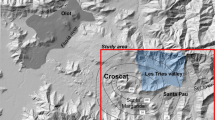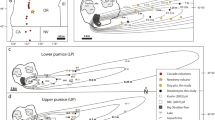Abstract
A devastating pyroclastic surge and resultant lahars at Mount St. Helens on 18 May 1980 produced several catastrophic flowages into tributaries on the northeast volcano flank. The tributaries channeled the flows to Smith Creek valley, which lies within the area devastated by the surge but was unaffected by the great debris avalanche on the north flank. Stratigraphy shows that the pyroclastic surge preceded the lahars; there is no notable “wet” character to the surge deposits. Therefore the lahars must have originated as snowmelt, not as ejected water-saturated debris that segregated from the pyroclastic surge as has been inferred for other flanks of the volcano. In stratigraphic order the Smith Creek valley-floor materials comprise (1) a complex valley-bottom facies of the pyroclastic surge and a related pyroclastic flow, (2) an unusual hummocky diamict caused by complex mixing of lahars with the dry pyroclastic debris, and (3) deposits of secondary pyroclastic flows. These units are capped by silt containing accretionary lapilli, which began falling from a rapidly expanding mushroom-shaped cloud 20 minutes after the eruption's onset. The Smith Creek valley-bottom pyroclastic facies consists of (a) a weakly graded basal bed of fines-poor granular sand, the deposit of a low-concentration lithic pyroclastic surge, and (b) a bed of very poorly sorted pebble to cobble gravel inversely graded near its base, the deposit of a high-concentration lithic pyroclastic flow. The surge apparently segregated while crossing the steep headwater tributaries of Smith Creek; large fragments that settled from the turbulent surge formed a dense pyroclastic flow along the valley floor that lagged behind the front of the overland surge. The unusual hummocky diamict as thick as 15 m contains large lithic clasts supported by a tough, brown muddy sand matrix like that of lahar deposits upvalley. This unit contains irregular friable lenses and pods meters in diameter, blocks incorporated from the underlying dry and hot pyroclastic material that had been deposited only moments earlier. The hummocky unit is the deposit of a high-viscosity debris flow which formed when lahars mingled with the pyroclastic materials on Smith Creek valley floor. Overlying the debris flow are voluminous pyroclastic deposits of pebbly sand cut by fines-poor gas-escape pipes and containing charred wood. The deposits are thickest in topographic lows along margins of the hummocky diamict. Emplaced several minutes after the hot surge had passed, this is the deposit of numerous secondary pyroclastic flows derived from surge material deposited unstably on steep valley sides.
Similar content being viewed by others
References
Brugman MM, Meier MF (1981) Response of glaciers to the eruptions of Mount St. Helens. In: Lipman PW, Mullineaux DR (eds) The 1980 eruptions of Mount St. Helens, Washington. US Geol Surv Prof Paper 1250:743–756
Crandell DR (1971) Postglacial lahars from Mount Rainier volcano, Washington. US Geol Surv Prof Paper 677:1–75
Crandell DR, Hoblitt RP (1986) Lateral blasts at Mount St. Helens and hazard zonation. Bull Volcanol 48:27–37
Fisher RV (1983) Flow transformations in sediment gravity flows. Geology 11:273–274
Fisher RV, Glicken HX, Hoblitt RP (1987) May 18, 1980 Mount St. Helens deposits in South Coldwater Creek, Washington. J Geophys Res 92:10267–10283
Fisher RV, Schmincke HU (1984) Pyroclastic rocks. Springer, Berlin Heidelberg New York, pp 1–472
Folk RL (1966) A review of grain-size parameters. Sedimentology 6:73–93
Hoblitt RP, Miller CD, Vallance JW (1981) Origin and stratigraphy of the deposit produced by the May 18 directed blast. In: Lipman PW, Mullineaux DR (eds) The 1980 eruptions of Mount St. Helens, Washington. US Geol Surv Prof Paper 1250:401–419
Hoblitt RP, Miller CD (1984) Comment on “Mount St. Helens 1980 and Mount Pelee 1902-flow or surge?” Geology 12:692–693
Janda RJ, Scott KM, Nolan KM, Martinson HA (1981) Lahar movement, effects, and deposits. In: Lipman PW, Mullineaux DR (eds) The 1980 eruptions of Mount St. Helens, Washington. US Geol Surv Prof Paper 1250:461–478
Johnson AM (1970) Physical processes in geology. Freeman, San Francisco, pp 1–577
Jonsson J (1982) Notes on the Katla volcanoglacial debris flows. Jokull 32:61–68
Kellerhals R, Bray DI (1971) Sampling procedures for coarse fluvial sediments. ASCE J Hyd Division 97 HY 8:1065–1180
Kieffer SW (1981) Fluid dynamics of the May 18 blast at Mount St. Helens. In: Lipman PW, Mullineaux DR (eds). The 1980 eruptions of Mount St. Helens, Washington. US Geol Surv Prof Paper 1250:379–400
Lorenz V (1970) Some aspects of the eruption mechanism of the Big Hole maar, central Oregon. Geol Soc Amer Bull 81:1823–1830
Lorenz V (1974a) Vesiculated tuffs and associated features. Sedimentology 21:273–291
Lorenz V (1974b) Studies of the Surtsey tephra deposits. Surtsey Res Prog Rept VII: 72–79
Major JJ (1984) Geological and rheologic characteristics of the May 18, 1980 southwest flank lahars at Mount St. Helens, Washington. MS thesis Penn State Univ, pp 1–225
Major JJ; Voight B (1986) Sedimentology and clast orientations of the 18 May 1980 southwest-flank lahars, Mount St. Helens, Washington. J Sed Pet 56:691–705
Malin MC, Sheridan MF (1982) Computer-assisted mapping of pyroclastic surges. Science 217:637–640
Malone SD, Weaver C, Endo E (1980) Seismic details of the May 18, 1980, cataclysmic eruption of Mount St. Helens (Abs). EOS, Trans Am Geophys Union 62:62
Martinson HA, Finneran SD, Topinka LJ (1984) Changes in channel geomorphology of six eruption-affected tributaries of the Lewis River, 1980–1982, Mount St. Helens. US Geol Surv Open-File Report 84-614
Martinson HA, Hammond HE, Mast WW, Mango PD (1986) Channel geometry and hydrologic data for six eruption-affected tributaries of the Lewis River, Mount St. Helens, Washington, water years 1983–84. US Geol Open-File Report 85-631
Middleton GV, Hampton MA (1976) Subaqueous sediment transport and deposition by sediment gravity flows. In: Stanely DJ, Swift DP (eds) Marine sediment transport and environmental management. Wiley, New York, pp 197–218
Moore JG (1967) Base surge in recent volcanic eruptions. Bull Volcanol 30:337–363
Moore JG, Albee WC (1981) Topographic and structural changes, March–July 1980 — Photogrammetric data. In: Lipman PW, Mullineaux DR (eds) The 1980 eruptions of Mount St. Helens, Washington. US Geol Surv Prof Paper 1250:123–134
Moore JG, Sisson TW (1981) Deposits and effects of the May 18 pyroclastic surge. In: Lipman PW, Mullineaux DR (eds) The 1980 eruptions of Mount St. Helens, Washington. US Geol Surv Prof. Paper 1250:421–438
Nairn IA (1979) Rotomahana-Waimangu eruption 1886 — base surge and basalt magma. NZ J Geol Geophys 22:363–378
Pierson TC (1985) Initiation and flow behavior of the 1980 Pine Creek and Muddy River lahars, Mount St. Helens, Washington. Geol Soc Am Bull 96:1056–1069
Pierson TC, Scott KM (1985) Downstream dilution of a Lahar — transition from debris flow to hyperconcentrated streamflow. Water Resource Research 21:1511–1524
Rosenbaum JG, Waitt RB (1981) Summary of eyewitness accounts of the May 18, 1980, eruption. In: Lipman PW, Mullineaux DR (eds) The 1980 eruptions of Mount St. Helens, Washington. US Geol Surv Prof Paper 1250:53–67
Scott KM (1985a) Lahars and lahar-runout flows in the Toutle-Cowlitz River system, Mount St. Helens, Washington — origins, behavior, and sedimentology. US Geol Surv Open-File Report 86-500 (also in press as US Geol Surv Prof Paper 1447-A)
Scott KM (1985b) Lahars and flow transformations at Mount St. Helens, Washington, USA. In: Takai A (ed) Proceedings of the International Symposium on erosion, debris flow, and disaster prevention. Tokyo. The Erosion Control Engineering Society, Japan (SABO), pp 209–214
Self S (1983) Large-scale phreatomagmatic silicic volcanism: a case study from New Zealand. J Volcanol Geotherm Res 17:433–469
Sparks RSJ, Walker GPL (1973) The ground surge deposit: a third type of pyroclastic rock. Nature 241:62–64
Sparks RSJ, Self S, Walker GPL (1973) Products of Ignimbrite Eruptions. Geology 1:115–118
Varnes DJ (1978) Slope movement types and processes. In Schuster RL, Krizek RJ (eds) Landslides analysis and control. Trans Res Bd Nat Res Coun, Special Rep 76, p 11–33
Voight B (1981) Time scale for the first moments of the May 18 eruption. In Lipman PW, Mullineaux DR (eds) the 1980 eruptions of Mount St. Helens, Washington. US Geol Surv Prof. Paper 1250:69–86
Voight B, Glicken H, Janda RJ, Douglass PM (1981) Catastrophic rockslide avalanche of May 18. In: Lipman PW, Mullineaux DR (eds) The 1980 eruptions of Mount St. Helens, Washington. US Geol Surv Prof. Paper 1250:347–378
Voight B, Janda RH, Glicken H, Douglas PM (1983) Nature and mechanics of the Mount St. Helens rockslide-avalanche on 18 May 1980. Geotechnique 33:243–273
Waitt RB (1980) Stratigraphic relations between deposits of lateral surge, debris flow, and catastrophic floodwater at Mount St. Helens, 18 May 1980 (Abs). EOS, Trans Am Geophys Union 61:1135
Waitt RB (1981) Devastating pyroclastic density flow and attendant airfall of May 18-stratigraphy and sedimentology of deposits. In: Lipman PW, Mullineaux DR (eds) The 1980 eruptions of Mount St. Helens, Washington. US Geol Surv Prof Paper 1250:439–458
Waitt RB (1984a) Comment on “Mount St. Helens 1980 and Mount Pelee 1902 — flow or surge?” Geology 12:693
Waitt RB (1984b) Deposits and effects of devastating lithic pyroclastic density current from Mount St. Helens on 18 May 1980 — field guide for northeast radial. US Geol Surv Open File Report 84-839:1–10
Waitt RB (in press) Timed Stratigraphic and geomorphic relations between airfall and catastrophic-flow deposits of the 18 May 1980 eruption. In: Waitt RB (ed) Eruptions and deposits at Mount St. Helens volcano in 1980. US Geol Surv Prof Paper 1251
Waitt RB, Dzurisin D (1981) Proximal air-fall from the May 18 eruption — statigraphy and field sedimentology. In: Lipman PW, Mullineaux DR (eds) The 1980 eruptions of Mount St. Helens, Washington. US Geol Surv Prof Paper 1250:601–616
Waitt RB, Pierson TC, MacLeod NS, Janda RJ, Voight B, Holcomb RT (1983) Eruption-triggered avalanche, flood, and lahar at Mount St. Helens-effects of winter snowpack. Science 221:1394–1397
Walker GPL, McBroome LA (1983) Mount St. Helens 1980 and Mount Pelee 1902 — flow or surge? Geology 11:571–574
Walker GPL, Morgan LA (1984) Reply to “Mount St. Helens 1980 and Mount Pelee 1902 — flow or surge?” Geology 12:693–695
Wohletz DH, Sheridan MF (1983) Hydrovolcanic explosions II. Evolution of basaltic tuff rings and tuff cones. Amer J Science 282:385–413
Wright JV, Smith AL, Self S (1980) A working terminology of pyroclastic depos its. J Volcanol Geotherm Res 8:315–336
Author information
Authors and Affiliations
Rights and permissions
About this article
Cite this article
Brantley, S.R., Waitt, R.B. Interrelations among pyroclastic surge, pyroclastic flow, and lahars in Smith Creek valley during first minutes of 18 May 1980 eruption of Mount St. Helens, USA. Bull Volcanol 50, 304–326 (1988). https://doi.org/10.1007/BF01073588
Received:
Accepted:
Issue Date:
DOI: https://doi.org/10.1007/BF01073588




